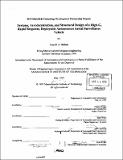MIT/DRAPER Technology Development Partnership Program : systems, aerodeceleration, and structural design of a high-G, rapid response, deployable autonomous aerial surveillance vehicle
Author(s)
Hallam, Cory R. A
DownloadFull printable version (10.47Mb)
Alternative title
Massachusetts Institute of Technology/Draper Technology Development Partnership Program
Systems, aerodeceleration, and structural design of a high-G, rapid response, deployable autonomous aerial surveillance vehicle
Advisor
Charles Boppe, Stan Weiss and Mark Spearing.
Terms of use
Metadata
Show full item recordAbstract
The MIT/Draper Technology Development Partnership Project is a two year initiative between MIT's Department of Aeronautics and Astronautics and Draper Laboratory (the funding customer) to develop an innovative, first-of-a-kind system. Through in-depth market research. concept generation. and reviews with Draper. the Wide Area Surveillance Projectile (WASP) was chosen as the lead technology demonstration project. The WASP is a gun-launched projectile in the 5"/54 NAVY to 155 mm ARMY class of munitions that transforms into a powered flight vehicle after traveling a ballistic trajectory. Once transformed, the WASP performs visual imaging reconnaissance and relays field data to the user via a Satcom or UAV signal link. This thesis covers much of the work conducted in the first year of the program. and focuses on Ballistics and aerodeceleration. Structures, and Systems Interface Design of the WASP. Although the two year timeline for the program precludes building the complete system, a series of "long-poles" are being used to demonstrate the concept functionality and feasibility for possible prototype development. These long-poles include the development of high-g composite structures, deployable flight surfaces. and a two-stroke propulsion system. as well as a virtual ground station with sensors/communications subsystems. and finally a drop-test flyer that will perform the vehicles intended mission scenario.
Description
Thesis (M.Eng.)--Massachusetts Institute of Technology, Dept. of Aeronautics and Astronautics, 1997. Includes bibliographical references (p. 123-127).
Date issued
1997Department
Massachusetts Institute of Technology. Department of Aeronautics and AstronauticsPublisher
Massachusetts Institute of Technology
Keywords
Aeronautics and Astronautics